[The St Ives artists] went on to produce some of the most exhilarating art of the twentieth century...for a few dazzling years this place was as famous as Paris, as exciting as New York and infinitely more progressive than London. – James Fox, presenter, The Art of Cornwall (BBC, 2010)
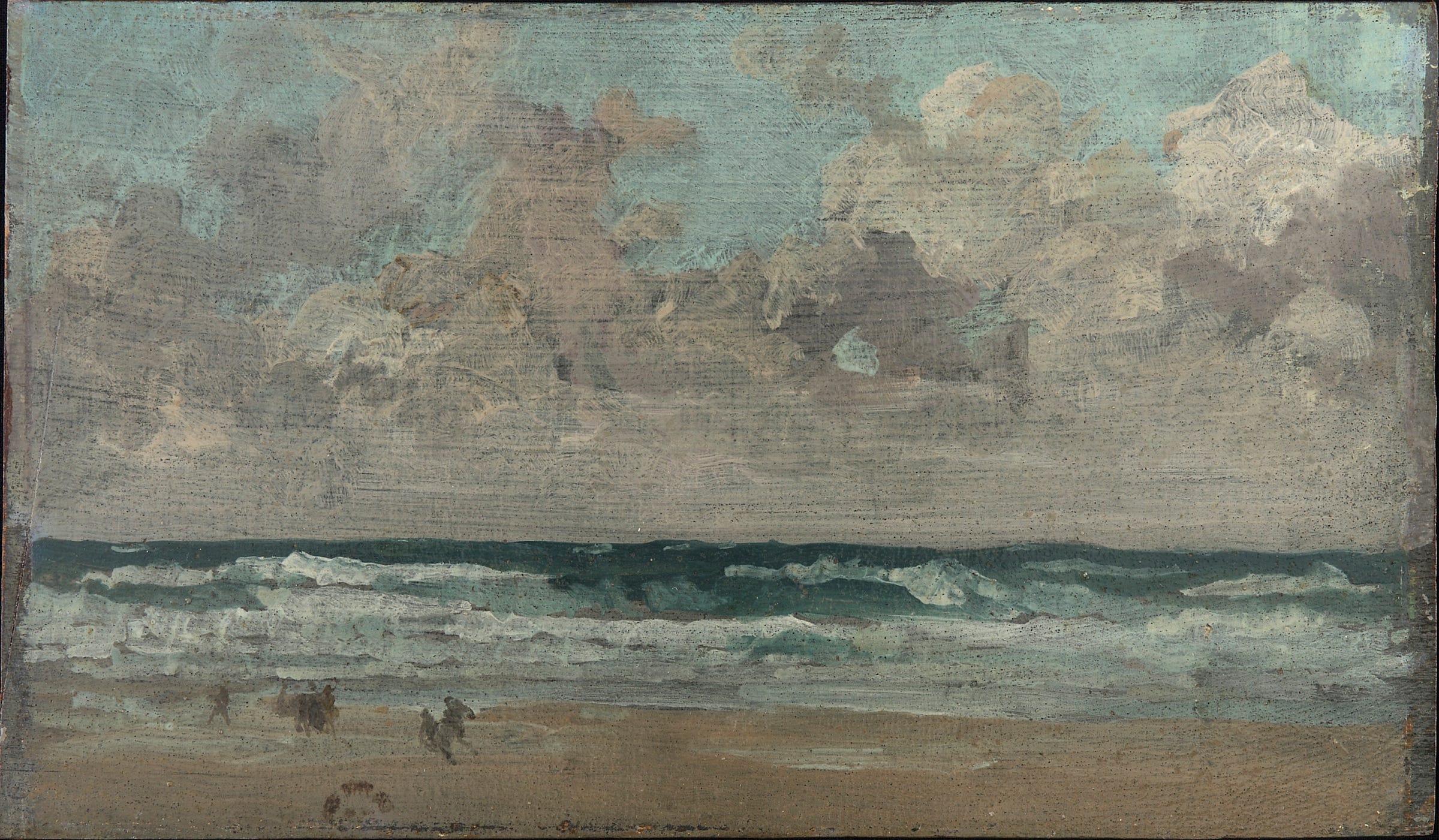
After several decades as an inspiring getaway for artists in Britain, the town of St Ives blossomed in the 1920s as the home of young artists bent on bringing Modernism to British art. The scenic beauty of the area had attracted the great British landscape painter J.M.W. Turner who visited the town in 1811. The 1877 extension of the Great Western Railway to St Ives on the western coast of Cornwall drew many visitors, including some notable artists.
In 1884, American expatriate painter J.A.M. Whistler and two students spent the winter in St Ives. A group of small paintings survive from this time, including Violet and Silver (c. 1884). In spite of its small size, the artist conveys a wide expanse of shore with large waves rolling in toward the blotchy figures on the sand. The violet and silver tones in the title appear throughout the clouds, which are darker to the left and brighter to the right. Above them, a blue sky hints at a change in the weather though the artist doesn’t make clear whether the change is for the better or worse. Whistler was always concerned with creating color and textural balance in his paintings and that appears in this little painting too. The smoothly brushed shore matches the texture of the cloudy horizon and contrasts with the more roughly painted sea and clouds, while the colors used, though few, are applied throughout the composition creating connections between land, sea, and sky.
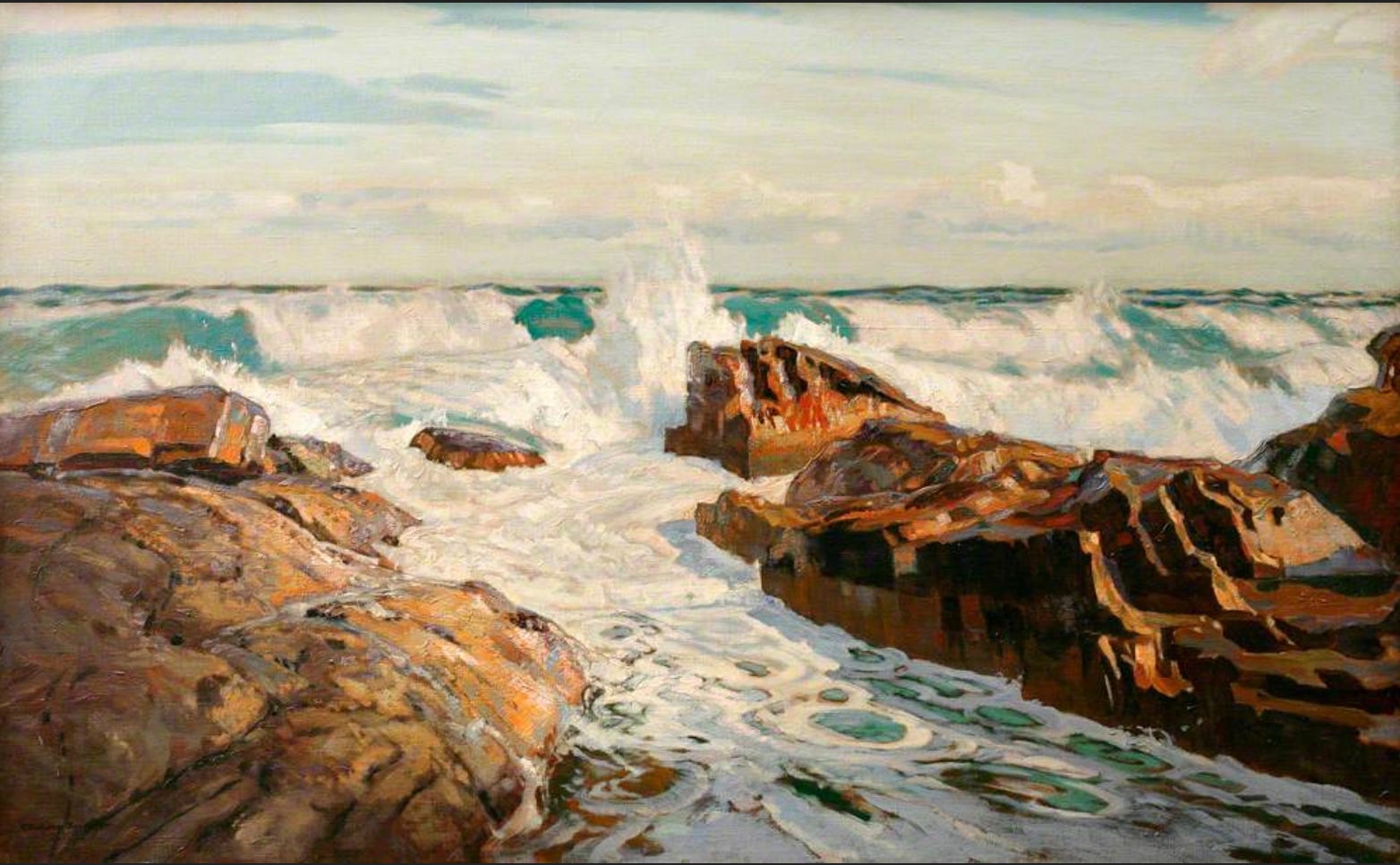
The first art school in St Ives was established in 1888 and the community of artists, whether permanent residents or occasional visitors, attracted like-minded others. In addition to the British, artists from around the world came to the small town to explore and depict the dramatic landscape. Quite a few Americans, mostly Impressionists, visited or stayed during the 1880s to 1900s. Perhaps the best known visitors in these early years were the Swedish painter Anders Zorn (1860-1920) and the Canadian artist Emily Carr (1871-1945).
The term St Ives School is not usually applied to the early groups and individuals who worked in the town. Instead, it refers to the artists who arrived in the town during and after World War One, though many remained in the area or returned many times over the decades of the 20th century. The term “School” in this context doesn’t refer to a formal teaching institution, instead it signifies a group of artists who worked in proximity to one another during a particular period of time. For the St Ives School, this time period is approximately the 1920s to the 1950s.
One of the founders of the St Ives School was Robert Borlase Smart, usually known as just Borlase Smart (British, 1881-1947), who painted and studied in Cornwall before WW1, settling there permanently in 1919 after his service in the war. An energetic organizer and promoter, Smart spent the remainder of his life working and teaching in St Ives. As can be seen in the painting above, Morning Light, St Ives (1922), Smart was a traditional naturalistic artist who specialized in capturing the ocean in various moods. This painting shows the golden Cornwall light which drew many people to the area. In spite of his preferred style, the artist encouraged more radical artists as they began to explore abstraction and non-representational form.

One of the most radical artists of the artists who arrived during World War Two was the Russian-born sculptor Naum Gabo (1890-1977). Already well traveled and familiar with Continental European avant-garde styles when he came to St Ives, Gabo brought his Constructivist style and artistic idealism to the art colony. The artist was deeply interested in scientific and technological innovations throughout his life but he also believed that spiritual experience was the source of artistic production. Gabo influenced many young artists to explore his conception of art as an abstract exploration of space. Construction in Space with Crystalline Centre created either in London or St Ives between 1938 and 1940 is small in scale but shows the artist’s fascination with new plastic materials. Most of the sculpture is made from Perspex, a new plastic introduced in 1935, which is transparent and flexible and more stable than the cellulose acetates Gabo had used in early plastic sculptures. The central “crystal” is made from Perspex surrounding thin celluloid sheets and shows the artist’s understanding of contemporary scientific studies of crystal and molecular structures. This rectilinear form contrasts with the outer structure of the sculpture with its asymmetrical, bent, and curving shapes. The transparent materials aided Gabo in his determination to depict space without mass; we see both the inside and outside of the artist’s dynamic form. There is only a slight difference between the surrounding surfaces and the openings cut into them. The difference was probably even less originally since preserving the original surface clarity of old plastics is notoriously difficult.

One reason that Gabo chose to settle in St Ives during WW2 was the presence of his friends Ben Nicholson (British, 1894-1982) and Barbara Hepworth (below). The artists had become friends when Gabo settled in London in 1939 to avoid the Nazi persecution of avant-garde artists. Nicholson and Gabo were editors of Circle, a publication which advocated for Modernist art styles like Gabo’s Constructivism. Nicholson first visited St Ives in 1928 where he met some of the resident artists but he was busy traveling in Europe in the 1920s and 30s where he encountered many of the leading Modernist artists, including Georges Braque, Alberto Giacometti and Piet Mondrian. In 1938, Nicholson married Hepworth (the second marriage for both) and a year later they left London to live permanently in St Ives.
Nicholson’s works range from pure geometric abstraction to Cubist-inspired still life and landscape. The example above, December 1951 (St Ives - oval and steeple), is an interesting mix of geometric shapes and specific references to the town of St Ives, as well as a blend of drawing and painting. The prominent geometric forms, especially the oval of the title, reflect an influential text circulating among the St Ives community in the 1940s and 50s. On Growth and Form by D’Arcy Wentworth Thompson was first published in 1917, then reissued in an expanded version in 1942. The author pointed out how underlying geometry can be discovered by studying the forms of nature. For Nicholson and Hepworth, as well as many others in the St Ives art colony, this discovery helped marry their Modernist tendencies to their attachment to the landscape. In Nicholson’s painting, the geometric frame within the composition opens like a book to reveal an unfolding cityscape rendered in outlines, patches of color and shading, and overlaid with the oval that appears and disappears as it overlaps other forms. This work’s hybrid painting-drawing form is common among St Ives School artists when they were experimenting with new approaches to abstraction.
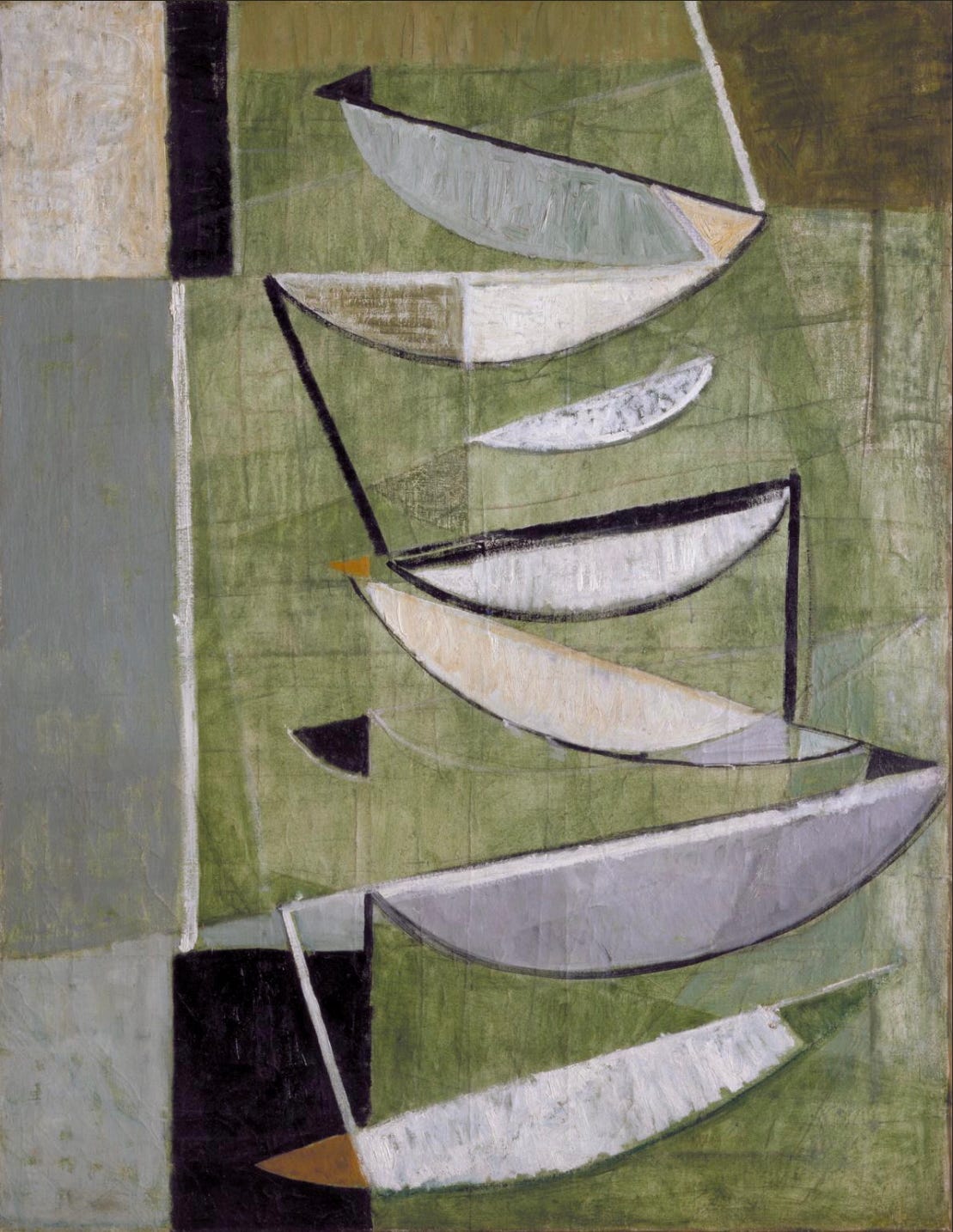
Terry Frost (British, 1915-2003) embarked on his painting career in his 30s, after serving in WW2 during which he spent time as a prisoner of war. A friend suggested he become a painter and after the war, Frost studied in Birmingham, St Ives, and finally London, where one of his teachers was Ben Nicholson. His studies encouraged him to explore abstraction and by 1951 he was settled with his family in St Ives. He worked as one of Barbara Hepworth’s assistants and became a member of St Ives Society of Artists. This group had been established in 1927 and eventually became associated with the more traditionalist artists of the colony. Wishing to bolster their ranks with the artists arriving in the late 20s and 30s, the Society encouraged the newcomers to exhibit with them in the Mariners’ Church. Unfortunately, the Modernist tendencies of the younger artists was disliked by the old guard, who by 1940 were hanging the more abstract works in darker areas like church’s crypt. One of the Society members, illustrator Harry Rountree (British, 1878-1950) declared that these artists should stop creating “French rot,” that is, the Modernist-influenced abstraction used in Nicholson’s and Frost’s works. As a result, the avant-gardists broke away in 1947 and created what they first called The Crypt Group in mocking reference to their treatment by the Society. In 1949, members of this group started the Penwith Society of Arts. It is these artists who make up what is now referred to as the St Ives School.
Frost’s Green, Black and White Movement (1951) is from the period when the artist was making his move from representational to purely abstract art. Based on the artist’s observations of the movement of boats in the harbor, it retains only slight references to observed reality and instead focuses on Frost’s subjective response to his experiences. This composition was constructed according to the Golden Section, a geometric ratio originating in ancient art and employed by Leonardo da Vinci and other artists of the Western tradition. (For a complete description of Frost’s use of geometry in this work, see the Artwork Information on the page dedicated to this painting on the Tate’s website.) The underlying framework for Frost’s geometry is visible through the thin layer of green paint, making us aware of the artist’s blending of formal geometry with the familiar landscape in which he lived for many years.

Far and away the best known and most influential of the St Ives School artists was Barbara Hepworth (British, 1903-1975). She most often described herself as a carver, but she also created sculptures in metal, paintings, drawings, textile designs, and prints. Working in London at the outbreak of WW2, Hepworth and Nicholson relocated their family to St Ives in 1939. The couple divorced in 1951; Nicholson left 1959, but Hepworth remained in St Ives until her death in a studio fire in 1975. Hepworth began creating purely abstract sculptures in the 1920s and 30s, though she returned to figural images in other media periodically.
… working realistically replenishes one's love for life, humanity and the earth. Working abstractly seems to release one's personality and sharpen the perceptions … The two ways of working flow into each without effort. It all feels the same – the same happiness and pain, the same joy in a line, a form, a color … – Barbara Hepworth
Spring (1966) is a bronze cast of a form the artist had executed in both wood and plaster earlier. Each version has a slightly different visual impact because of the materials of which it was made and the colors the artist chose for each.
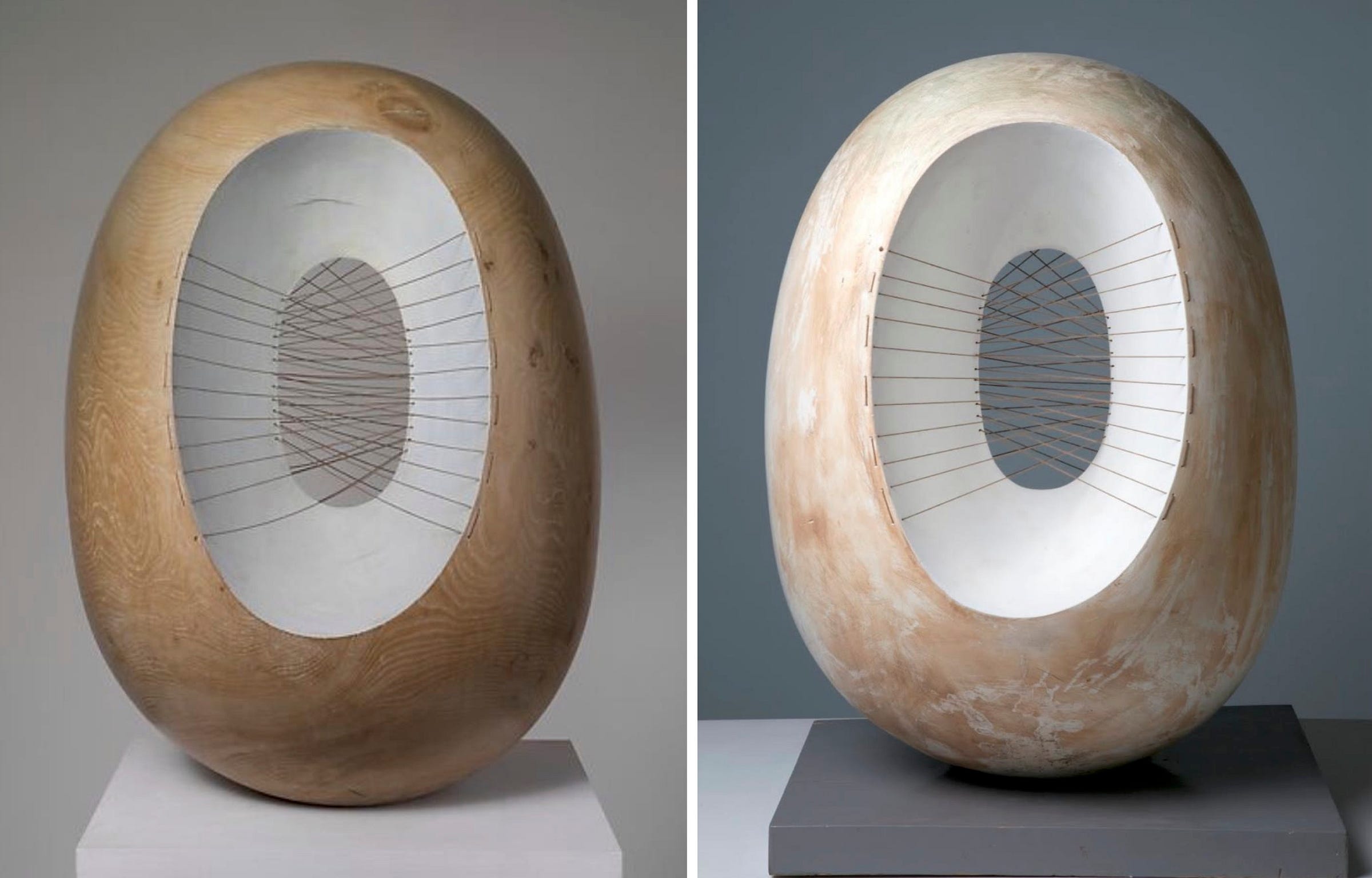
The first version (left, above), called Oval Form with Strings and Color , was carved from a single elm trunk. The artist allowed the woodgrain to remain visible in the finished work. The hollow void is painted white which contrasts with both the natural wood exterior and the criss-crossing strings making them more noticeable. The second, plaster, version (right, above) was cast from the elm version and is titled Spring. This object was the model from which the final bronze was cast. After that was done, the artist smoothed the plaster and added a slight brown patina to the exterior surface. Finally she attached the taut dark string which strongly contrasts with pure white depression.
Hepworth’s final bronze cast has a very dark patina on the exterior surface which heightens the viewer’s awareness of the pale turquoise patina of the center. The yellow-brown strings stand out against this color and, as in the other versions, create tension in contrast to the swelling oval form. The artist created many works using this tension between curving forms and taut lines, frequently also combining them with color contrasts. Underlying even Hepworth’s most abstract sculptures was the continuity she saw between her abstractions and traditional human images – tall vertical forms were figures standing in a landscape, double figures were a mother and child, and ovals like Spring signified an embrace of living things.
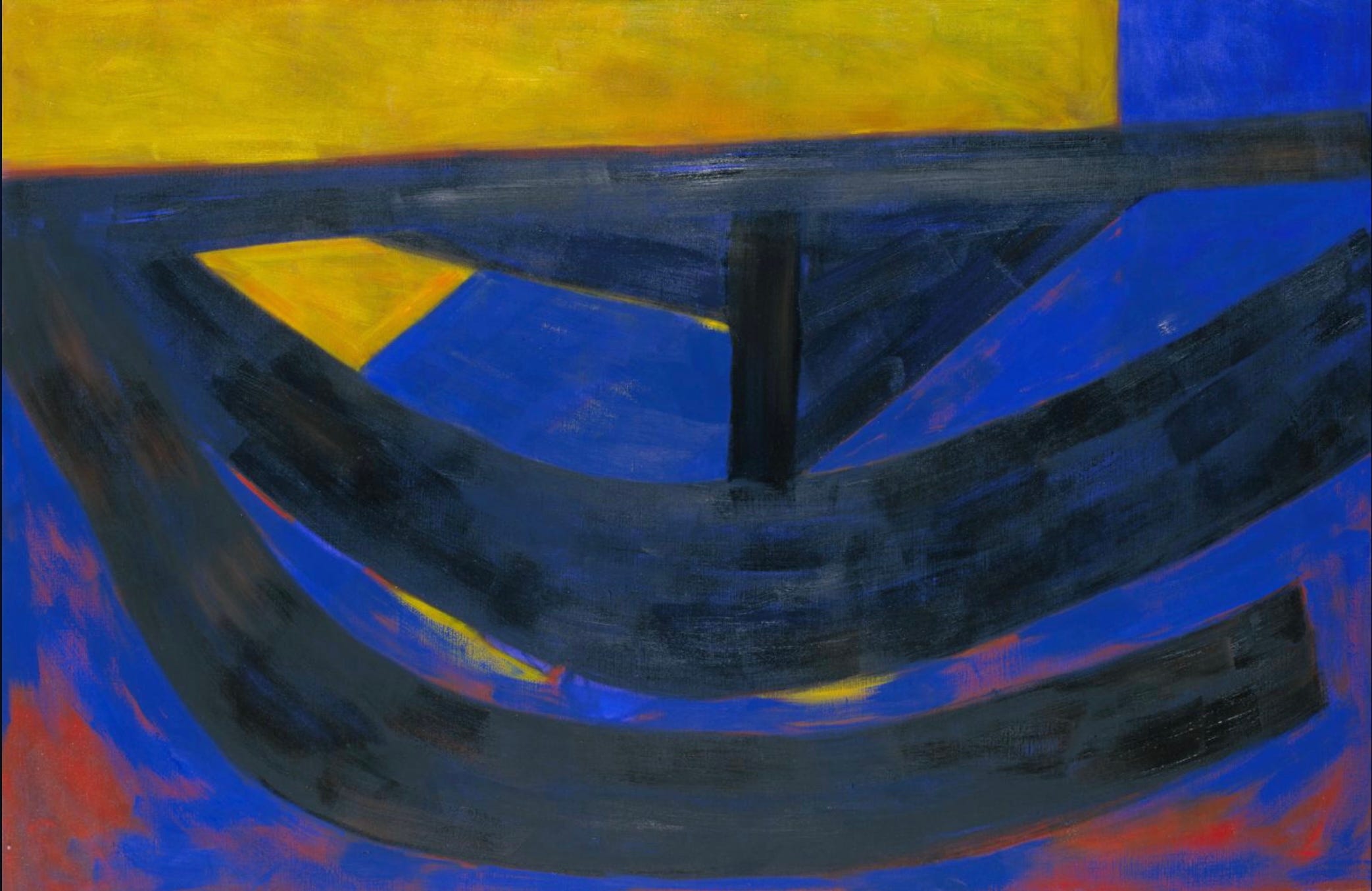
I close with a late work by Wilhemina Barns-Graham (British, 1912-2004). Born and educated in Scotland, this artist settled in Cornwall in 1940. On her first night in St Ives, she met Hepworth, an experience she found deeply meaningful. Soon she entered fully into the art colony, meeting other important artists and acquiring a studio. Like many of the young artists in the colony, she began blending abstraction into her landscape paintings, leading her works to be relegated to the crypt in exhibitions. As a result, she joined the Crypt Group when they split from the St Ives Society and was one of the founders of the Penwith Society of Arts in 1949. She had growing success, exhibiting in London and at the Scottish Royal Academy, as well as with the various St Ives groups. From 1960 until the end of her life, she spent summers in St Ives and winters at a home she’d inherited in Scotland.
Like many of her contemporaries, Barns-Graham focused increasingly on non-representational art in her later works. June Painting, Ultramarine and Yellow, from 1996 is characteristic of the vivid color found in many of her late works. Different textures are created by varying the density of the paint when it was applied. Some areas are glossy, mostly in the black sections, as if the paint was applied directly from the tube. In other parts, the paint was clearly thinned before application and appears more matte and flat. The yellow and ultramarine sections are more geometric while the red is patchy. These bright colors are overlaid with the broad black lines that to my eyes resemble a boat, though this may be due to the many sea-themed works I’ve encountered while exploring the St Ives School.
In my paintings I want to express the joy and importance of color, texture, energy and vibrancy, with an awareness of space and construction. A celebration of life – taking risks so creating the unexpected. – Wilhelmina Barns-Graham, October 2001
Awareness of Barns-Graham’s career declined in the late 20th century as St Ives fell out of favor with the avant-garde and as other painters of the area became the focus of art historians. Fortunately, she benefitted from renewed interest in women artists during the 1990s and 2000s. Fortunately this recognition, including honors bestowed in both England and Scotland, came before the artist’s death in 2004.
The St Ives School developed from the inspiration of the unique landscape of the Cornish coast and an influx of avant-garde ideas from Continental Europe. The artists were able to integrate these two influences to create a surprising artistic revolution far from the traditional artistic capitals of Europe but one which made itself felt across Britain and beyond.
An exhibition currently open at The Hepworth Wakefield, which is dedicated to Barbara Hepworth (who was born and educated in Wakefield) includes the artist’s Spring. “Resonant Forms” continues through January 2026. The Hepworth Wakefield, Gallery Walk, Wakefield, West Yorkshire, UK. https://hepworthwakefield.org/whats-on/resonant-forms/
Don’t forget to like, share, and comment on this post. Thank you so much for reading and subscribing. I’ll be back next week with more art.




Obviously, I liked the pre 1951 works best, but you already knew that didn't you.